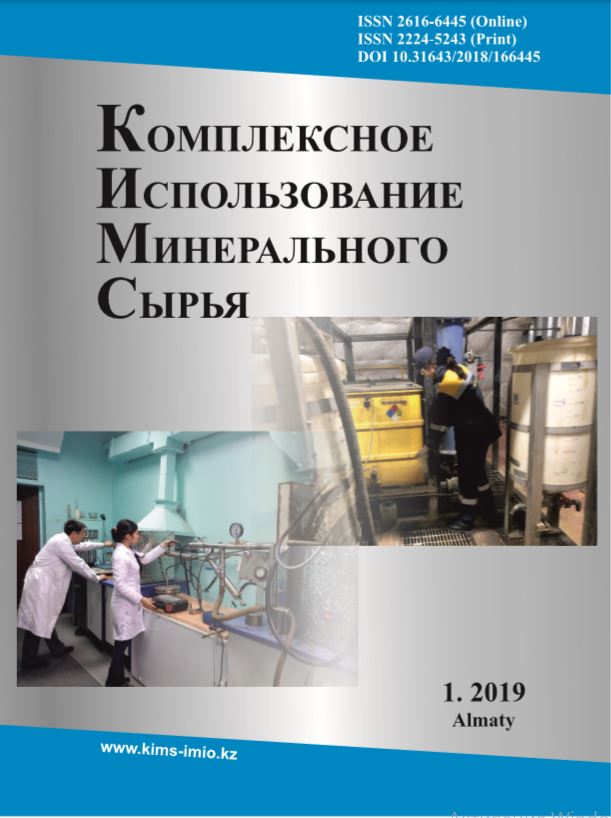Concentration limits of niobium and cadmium alloys existence, formed by ultrafine particles
DOI:
https://doi.org/10.31643/2019/6445.04Keywords:
ultrafine particle, Niobium, Cadmium, diffractogram, unit cell, solid solution, alloy.Abstract
Cd metals are established to form an alloy with a body-centered cubic structure up to a 64.5 at. % concentration as a result of determining the limits existence of Cadmium in Niobium solid solutions, obtained by plasma-assisted ion sputtering and ultrafine particles co-precipitation to a critical size. At this, two linear dependence sections in the range of 0 – 50.0 at. % and 50.0 – 64.5 at. % of Cadmium (the rest is Niobium) are found described by the equations a [nm] = 8•10-5x +0.3306 and a [nm] = 3•10-4x +0.32188 (respectively), where x is the Cadmium content in the alloy, at. %. At 68 at. % of Cadmium, an unknown phase was identified; no solid solutions of Niobium in the Cadmium were detected. The growth of the lattice parameter is due to the fact, that Cadmium atoms have a larger radius than Niobium atoms: (ra)Cd = 0,1727 нм, (ra)Nb = 0,1625 nm. The kink on the linear dependence of the lattice parameter of the Cadmium in Niobium solid solution as a result of Cadmium concentration in the alloy is explained by the fact that Cadmium first replaces the Niobium atom in the center of the unit cell, then is also embedded in the Niobium lattice with increasing its concentration replacing the Niobium atom in one of the cube vertices. The latter causes a more intense increase in the size of the unit cell. The possibility of the alloys formation in a wide range of concentrations as a result of thermal-fluctuation melting and the merging of very small unlike particles that have significant differences in physical properties, metal particles was confirmed, which is unattainable with the traditional thermal production method.
Downloads
References
Korshunov A.V. Parametry plavleniya poroshkov alyuminiya s razlichnoy dispersnostyu(Melting parameters of aluminum powders with different dispersity) Izvestiya Tomskogo politekhnicheskogo universiteta =News of Tomsk Polytechnic University.2013. 23, 3. 96-103 (in Russ.).
Bogatyrenko S.I., Gladkikh N.T., Kryshtal’ A.P. Ponizheniye temperatury plavleniya s umensheniyem tolshchiny plenok Bi. In. Pb i Sn v Al –matritse(Decrease in the melting temperature with a decrease in the thickness of Bi, In, Pb, and Sn films in the Al matrix).Zhurnal fiziki i inzhenerii poverkhnosti = Journal of Surface Physics and Engineering.2003. 1. 82-88 (in Russ.).
Sergeev G.B., Shabatina T.I. Low temperature surface chemistry and nanostructures. Surface Science. 2002. 500. 628-655. (in Eng.).
Mohammad A. J. Size, shape and temperature dependent surface energy of bi-nary alloy nanoparhticles. Applied Surface Science. 2017. 426. 1094-1099. https://doi.org/10.1016/j.apsusc.2017.07.242(in Eng.).
Roduner E. Size matters: why nanomaterials are different. Chemical Society Reviews. 2006. 35. 583-592. (in Eng.).
Roduner E. Razmernye effekty v nanomaterialakh(Dimensional effects in nanomaterials).Moscow. Tekhnosfera. 2010. 350. (in Eng.).
Dukarov S.V., Petrushenko S.I., Sukhov V.N., Churilov I.G. Pereokhlazhdeniye pri kristallizatsii vismuta v mnogosloynykh plenkakh Cu-Bi-Cu i C-Bi-C.(Supercooling during the crystallization of bismuth in multilayer films Cu-Bi-Cu and C-Bi-C).Zhurnal fiziki i inzhenerii poverkhnosti = Journal of Surface Physics and Engineering. 2013. 11, 4. 345-350.
Volodin V.N., Tuleushev Yu.Zh., Trebukhov S.A., Nitsenko A.V., Burabayeva N.M. Razmernyy effekt pri formirovanii splava niobiya s kadmiyem ul’tradispersnymi chastitsami pri nizkoy temperature(Dimensional effect in the formation of a niobium alloy with cadmium ultrafine particles at low temperature). Kompleksnoe Ispolʹzovanie Mineralʹnogo syrʹâ. 2018. 4.98–104.(in Russ.). https://doi.org/10.31643/2018/6445.35
Volodin V.N., Bayanzhanova Sh.T., Khrapunov V.E., Terlikbayev M.A., Vasilets S.G. Zavodskiye ispytaniya vakuumdistillyatsionnogo rafinirovaniya kadmiya s vysokim soderzhaniyem primesey(Factory tests of cadmium vacuum-distillation refining with a high content of impurities). Kompleksnoye ispol’zovaniye mineral’nogo Syr’ya. 2005. 6. 21-27.(in Russ.).
Volodin V.N. Fizicheskaya khimiya i tekhnologiya rafinirovaniya kadmiya(Physical chemistry and technology of cadmium refining). Almaty, Print-S, 2011. 238. (in Russ.).
Downloads
Published
How to Cite
Issue
Section
License
Copyright (c) 2019 Volodin, V., Tuleushev, Y., Nitsenko, A., & Burabaeva, N.

This work is licensed under a Creative Commons Attribution-NonCommercial-NoDerivatives 3.0 Unported License.


























